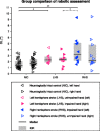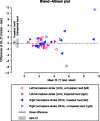Reliability, validity, and clinical feasibility of a rapid and objective assessment of post-stroke deficits in hand proprioception
- PMID: 29880003
- PMCID: PMC5991441
- DOI: 10.1186/s12984-018-0387-6
Reliability, validity, and clinical feasibility of a rapid and objective assessment of post-stroke deficits in hand proprioception
Abstract
Background: Proprioceptive function can be affected after neurological injuries such as stroke. Severe and persistent proprioceptive impairments may be associated with a poor functional recovery after stroke. To better understand their role in the recovery process, and to improve diagnostics, prognostics, and the design of therapeutic interventions, it is essential to quantify proprioceptive deficits accurately and sensitively. However, current clinical assessments lack sensitivity due to ordinal scales and suffer from poor reliability and ceiling effects. Robotic technology offers new possibilities to address some of these limitations. Nevertheless, it is important to investigate the psychometric and clinimetric properties of technology-assisted assessments.
Methods: We present an automated robot-assisted assessment of proprioception at the level of the metacarpophalangeal joint, and evaluate its reliability, validity, and clinical feasibility in a study with 23 participants with stroke and an age-matched group of 29 neurologically intact controls. The assessment uses a two-alternative forced choice paradigm and an adaptive sampling procedure to identify objectively the difference threshold of angular joint position.
Results: Results revealed a good reliability (ICC(2,1) = 0.73) for assessing proprioception of the impaired hand of participants with stroke. Assessments showed similar task execution characteristics (e.g., number of trials and duration per trial) between participants with stroke and controls and a short administration time of approximately 12 min. A difference in proprioceptive function could be found between participants with a right hemisphere stroke and control subjects (p<0.001). Furthermore, we observed larger proprioceptive deficits in participants with a right hemisphere stroke compared to a left hemisphere stroke (p=0.028), despite the exclusion of participants with neglect. No meaningful correlation could be established with clinical scales for different modalities of somatosensation. We hypothesize that this is due to their low resolution and ceiling effects.
Conclusions: This study has demonstrated the assessment's applicability in the impaired population and promising integration into clinical routine. In conclusion, the proposed assessment has the potential to become a powerful tool to investigate proprioceptive deficits in longitudinal studies as well as to inform and adjust sensorimotor rehabilitation to the patient's deficits.
Keywords: Difference threshold; MCP; Metacarpophalangeal joint; Parameter Estimation by Sequential Testing; Psychophysics; Quantitative measurements; Robot-assisted assessment; Somatosensory function.
Conflict of interest statement
Ethics approval and consent to participate
The study was approved by the institutional ethics committee of the University of Konstanz. All subjects gave signed, written informed consent in accordance with the Declaration of Helsinki before participating in the experiment.
Competing interests
The authors declare that they have no competing interests.
Publisher’s Note
Springer Nature remains neutral with regard to jurisdictional claims in published maps and institutional affiliations.
Figures



Similar articles
-
Reliable and valid robot-assisted assessments of hand proprioceptive, motor and sensorimotor impairments after stroke.J Neuroeng Rehabil. 2021 Jul 16;18(1):115. doi: 10.1186/s12984-021-00904-5. J Neuroeng Rehabil. 2021. PMID: 34271954 Free PMC article.
-
A robotic test of proprioception within the hemiparetic arm post-stroke.J Neuroeng Rehabil. 2014 Apr 30;11:77. doi: 10.1186/1743-0003-11-77. J Neuroeng Rehabil. 2014. PMID: 24885197 Free PMC article.
-
Age-based model for metacarpophalangeal joint proprioception in elderly.Clin Interv Aging. 2017 Apr 6;12:635-643. doi: 10.2147/CIA.S129601. eCollection 2017. Clin Interv Aging. 2017. PMID: 28435235 Free PMC article.
-
Upper Extremity Proprioception After Stroke: Bridging the Gap Between Neuroscience and Rehabilitation.J Mot Behav. 2017 Jan-Feb;49(1):27-34. doi: 10.1080/00222895.2016.1219303. Epub 2016 Oct 11. J Mot Behav. 2017. PMID: 27726645 Review.
-
Sensorimotor interventions and assessments for the hand and wrist: a scoping review.J Hand Ther. 2014 Oct-Dec;27(4):272-85; quiz 286. doi: 10.1016/j.jht.2014.07.002. Epub 2014 Jul 24. J Hand Ther. 2014. PMID: 25193532
Cited by
-
Enhancing simulations with intra-subject variability for improved psychophysical assessments.PLoS One. 2018 Dec 31;13(12):e0209839. doi: 10.1371/journal.pone.0209839. eCollection 2018. PLoS One. 2018. PMID: 30596761 Free PMC article.
-
The Cortical Response Evoked by Robotic Wrist Perturbations Reflects Level of Proprioceptive Impairment After Stroke.Front Hum Neurosci. 2021 Nov 9;15:695366. doi: 10.3389/fnhum.2021.695366. eCollection 2021. Front Hum Neurosci. 2021. PMID: 34858150 Free PMC article.
-
The Role of Sensory Impairments on Recovery and Rehabilitation After Stroke.Curr Neurol Neurosci Rep. 2025 Mar 6;25(1):22. doi: 10.1007/s11910-025-01407-9. Curr Neurol Neurosci Rep. 2025. PMID: 40047982 Free PMC article. Review.
-
Assessing kinesthetic proprioceptive function of the upper limb: a novel dynamic movement reproduction task using a robotic arm.PeerJ. 2021 May 3;9:e11301. doi: 10.7717/peerj.11301. eCollection 2021. PeerJ. 2021. PMID: 33987004 Free PMC article.
-
Multisensory Integration in Stroke Patients: A Theoretical Approach to Reinterpret Upper-Limb Proprioceptive Deficits and Visual Compensation.Front Neurosci. 2021 Apr 7;15:646698. doi: 10.3389/fnins.2021.646698. eCollection 2021. Front Neurosci. 2021. PMID: 33897359 Free PMC article.
References
Publication types
MeSH terms
LinkOut - more resources
Full Text Sources
Other Literature Sources
Medical
Miscellaneous

